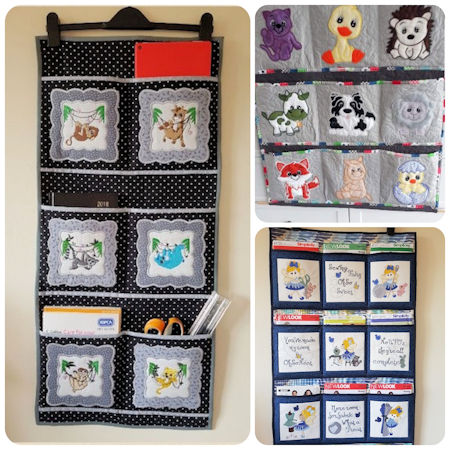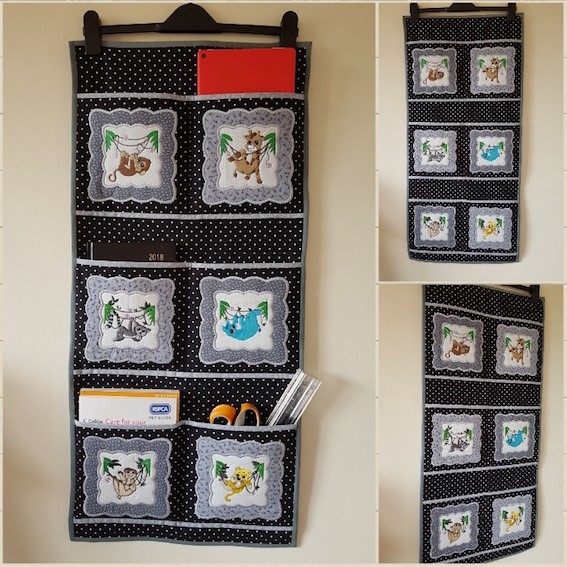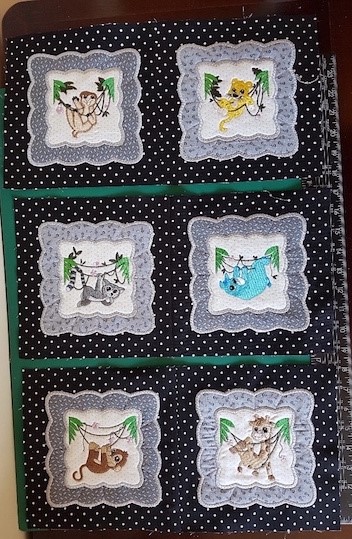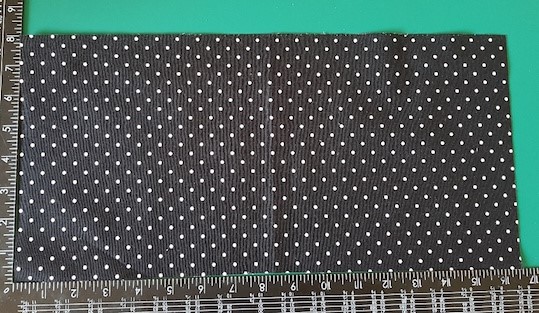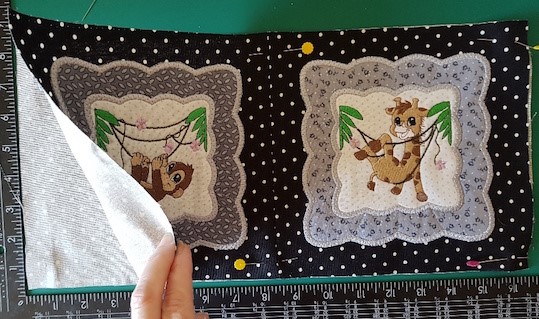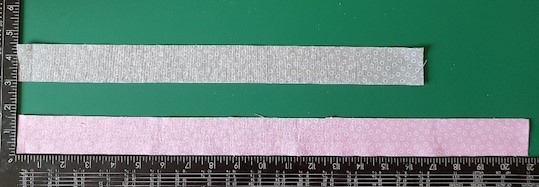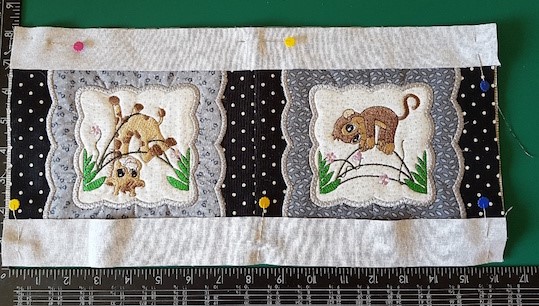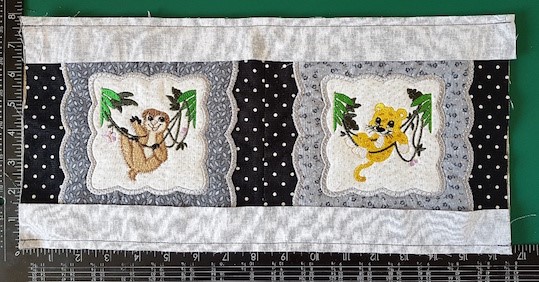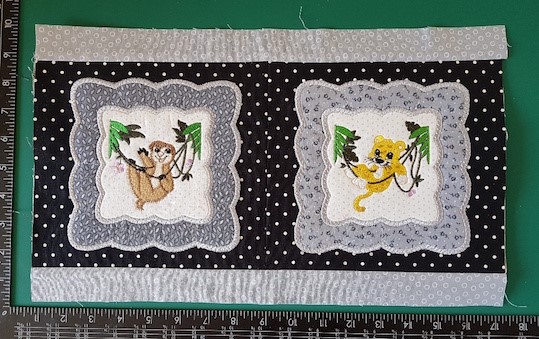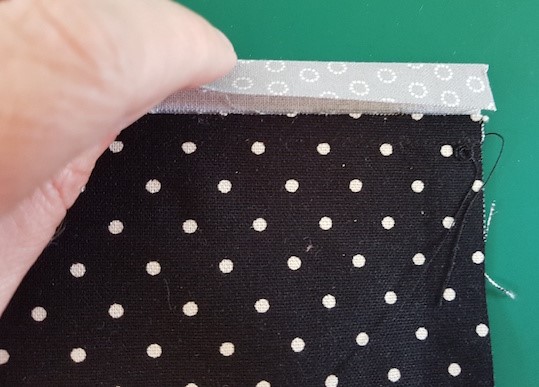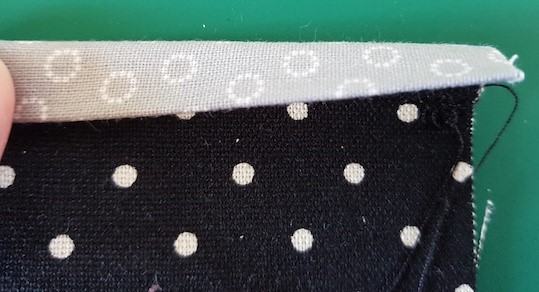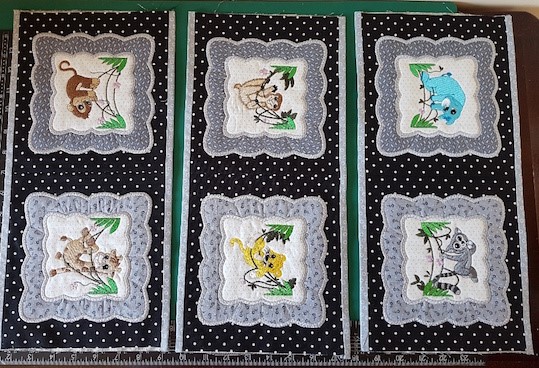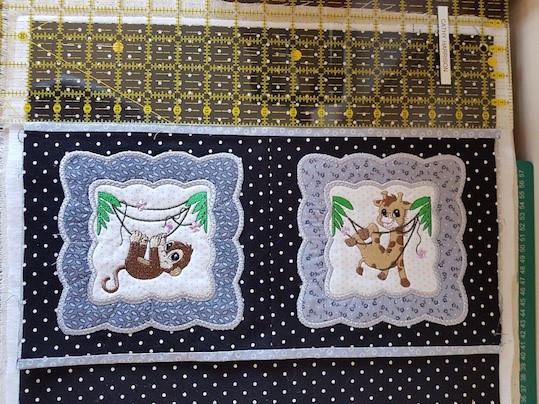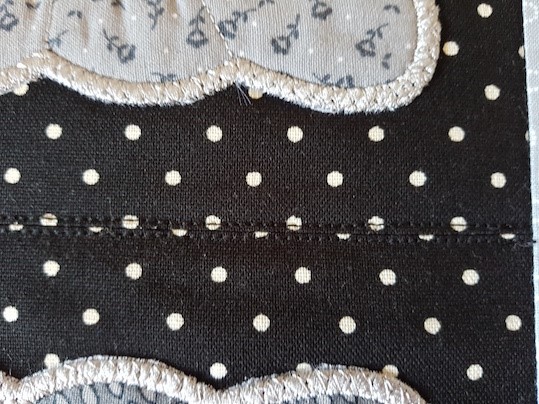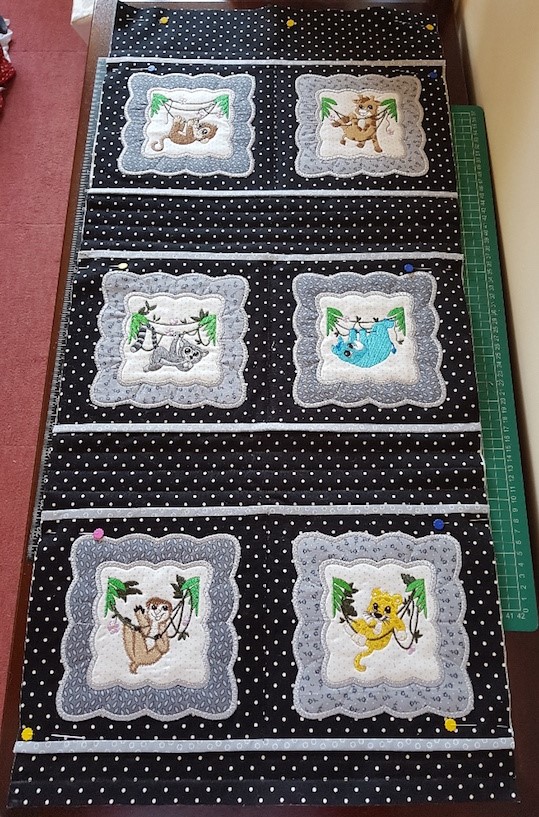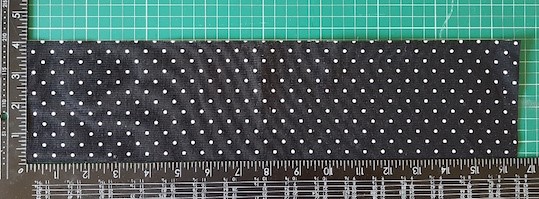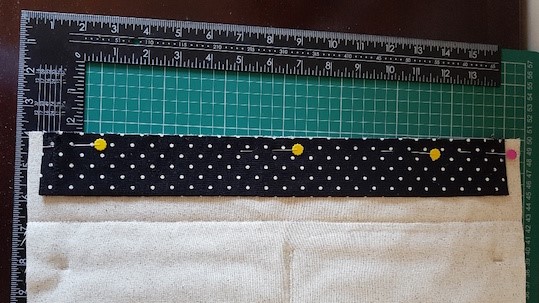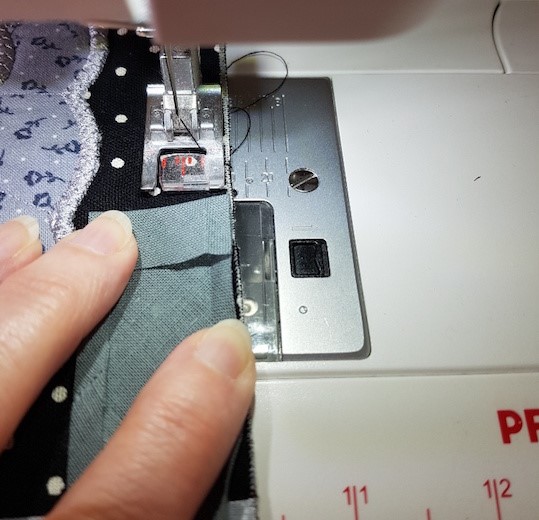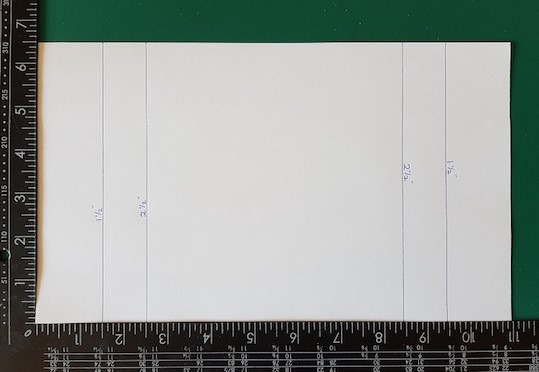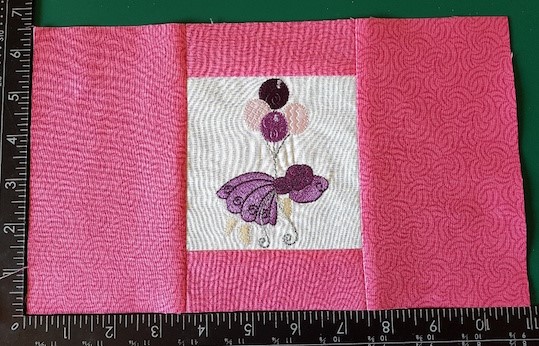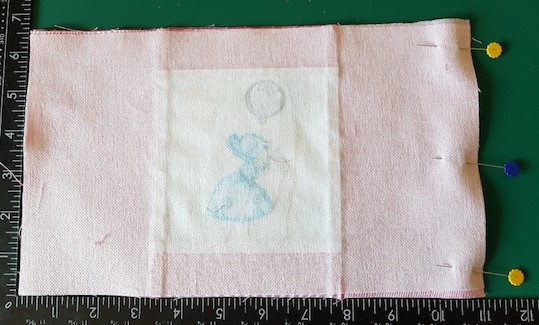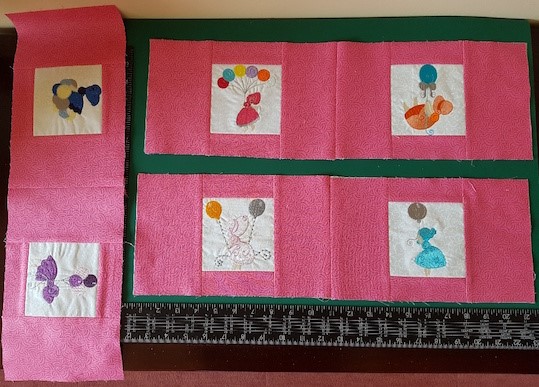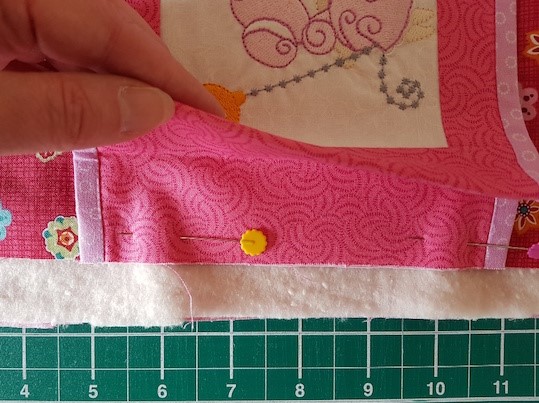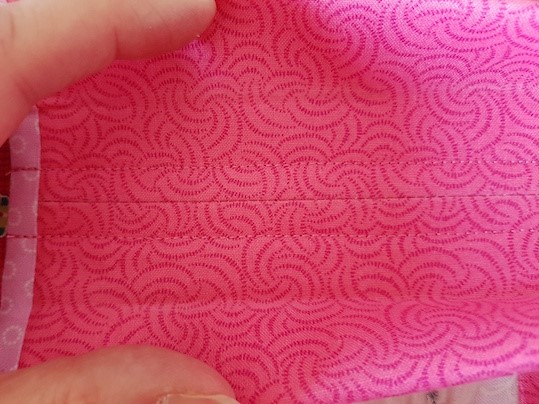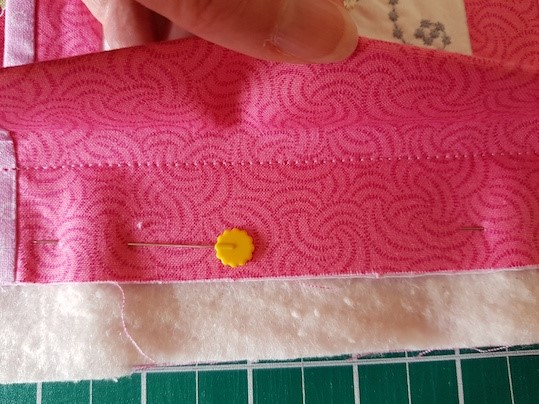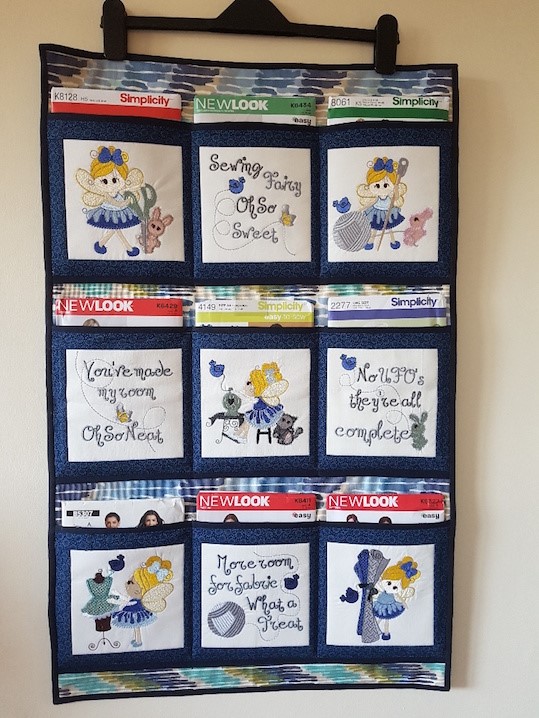How to make a Pocket Wall Hanger
Blog Post by Cathy Harrison of Pickle Creations
Ready for a project that's not only a wonderful way to showcase your Embroidery, but practical as well?
Cathy shows us how to Make a decorative pocket wall hanger, with 6 pockets, which can be made in two styles:
1) Slip pockets, good for a beginner,
2) Pleated pockets, a little more fiddly
Idea for these items were from the excellent make posted by Jo Bendall, of her 9 pocket hanger posted on Kreative Kiwi
DOWNLOAD PRINT FRIENDLY VERSION
Slip Pocket Style |
Pleated Pocket Style.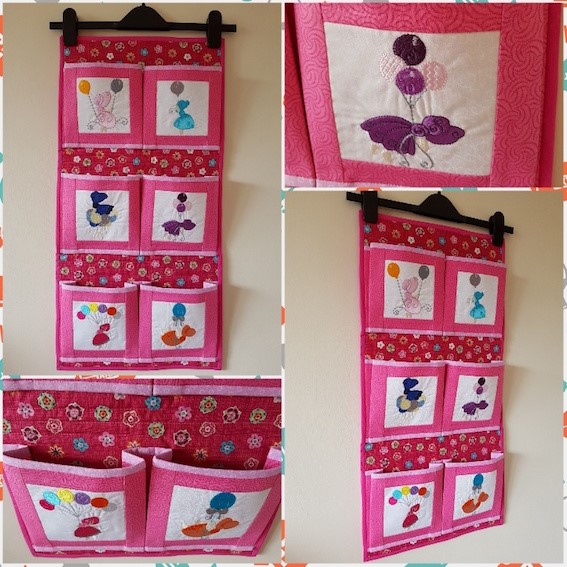 |
Cutting List – Option 1 Slip Pockets
|
Number Required |
Dimensions |
Material |
Comments |
|
6 |
8 ½” x 8 ½” |
Cotton canvas / cotton. |
Square pocket fronts |
|
3 |
8” x 16 ½” |
Cotton |
Pocket linings |
|
6 |
1 ½” x 16 ½” |
Cotton |
Binding strips, for pockets. |
|
3 |
8” x 16 ½” |
Interfacing |
|
|
1 |
16 ½” x 35” |
Cotton canvas / cotton. |
Back panel front |
|
1 |
16 ½” x 35” |
Cotton |
Back panel, backing |
|
1 |
16 ½” x 35” |
Wadding |
Back panel wadding |
|
1 |
16 ½” x 4” |
Cotton canvas / cotton. |
Dowel holder, for hanging by. |
|
|
|
Bias binding |
|
Cutting List – Option 2 Pleated Pockets
|
Number Required |
Dimensions |
Material |
Comments |
|
6 |
6 ½” x 11” |
Cotton canvas / cotton. |
Pocket fronts |
|
3 |
6” x 21” |
Cotton |
Pocket linings |
|
6 |
1 ½” x 21” |
Cotton |
Binding strips, for pockets. |
|
3 |
6” x 21” |
Interfacing |
|
|
1 |
12 ¾” x 29” |
Cotton canvas / cotton. |
Back panel front |
|
1 |
12 ¾” x 29” |
Cotton |
Back panel, backing |
|
1 |
12 ¾” x 29” |
Wadding |
Back panel wadding |
|
1 |
16 ½” x 4” |
Cotton canvas / cotton. |
Dowel holder, for hanging by. |
|
|
|
Bias binding |
|
Note: It is advisable to cut as you progress through the instructions, rather than cut out all pieces at the start, as some pieces are trimmed down to final size. With the pleated design especially.
Use of Interfacing
Depending on your material it may be a good idea to add interfacing, to the pocket linings, for a little more stiffness. I used interfacing on the type 2) Pleated, but did not on the type 1) Slip shown in these instructions, as the combination of cotton canvas material and the appliqué together provided enough stiffness.
Types – deciding on pocket style and size
1) Slip pockets, using “Jumping Jungle” a Member Freebie (Log into your account, or Sign Up) and Scallop Coaster
2) Pleated pockets, using SB Balloons
Deciding on pocket style and how many pockets are needed.
Jo used 9 pockets, 3 rows of 3, for her hanger. For these instructions of both types I will be using 3 rows of 2. The slip pockets will be an 8” finished pocket size and the pleated pockets will be 6” finished size.
STEP 1 – Cutting out Slip pockets
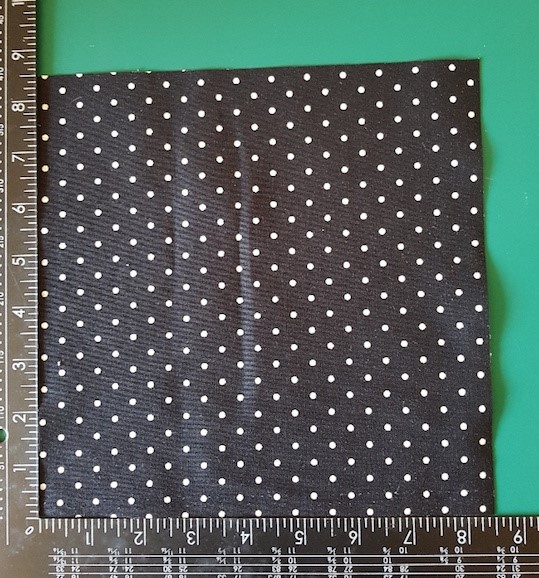 |
|
I am using a finished size of 8” square, mainly to accommodate my appliqué design. I am also having 6 pockets, which will be 3 rows of 2 pockets. |
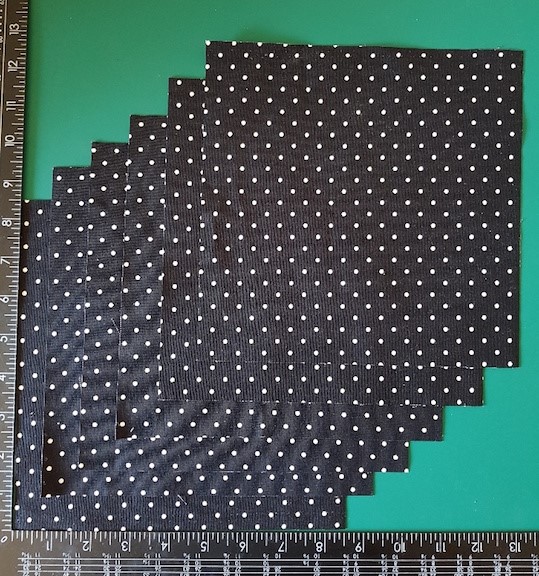 |
|
Cut out 6 squares of pocket fabric, each measuring 8 ½” square. IMPORTANT : If you choose to embroider directly onto your squares, do NOT cut your square to 8 ½” by 8 ½”, until embroidery is complete to ensure the design is central. |
STEP 2 – Attaching Appliqué
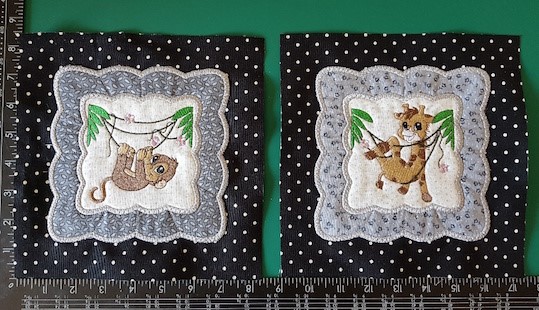 |
|
Apply appliqué design, to each square. Note that for the embroidery I combined “Jumping Jungle” with “Scallop Coaster” |
STEP 3 – Joining Squares
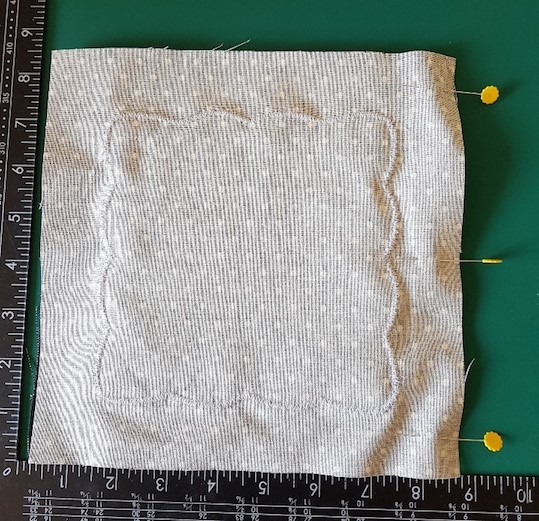 |
|
Using a ¼” seam allowance, join the squares, by placing 2 squares right sides together. I am doing 3 rows of 2 pockets, so I will only be joining 2 squares together. Note: Ensure orientation of appliqué is correct, before joining. |
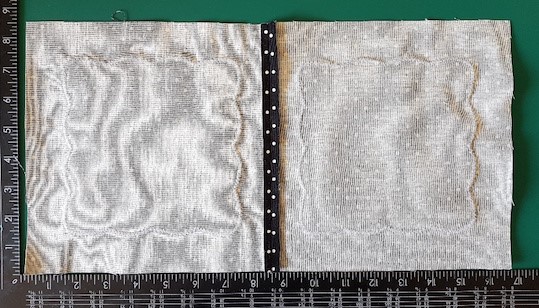 |
|
Press with seams open. |
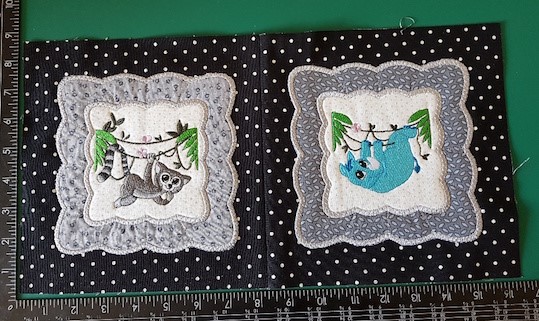 |
|
Trim the height of each pocket block to the finished measurements. I do this now as sometimes when joining the material may slip, or, stretch. Trimming now therefore helps give a better finish. Type 1) Slip will be trimmed to 8” high. |
|
|
|
3 rows of 2 joined pockets, trimmed to 8” high. |
STEP 4 – Making the Pockets
|
|
|
Now to add the lining. Start by measuring the joined panels. Mine were 8” x 16 ½”. Cut the lining pieces to match these measurements. You should have 3 pieces of lining fabric, each being 8” x 16 ½”. As explained on Page 4, you may wish to consider interfacing, depending on your material choice. |
|
|
|
To attach the lining to the pocket panels. With wrong sides together place the pocket lining and panels, pin and then machine tack along the long edge with a ¼” seam. |
|
|
|
The above picture shows the binding strips for both Type 1) Slip and Type 2) Pleated. So in this case we will need to cut 6 binding strips each of 16 ½” by 1½” for the Slip style.
|
|
|
|
Place the binding strip on top of the panel, wrong sides together, on the top and bottom of the panel and pin or clip in place. |
|
|
|
Sew in place with a ¼” seam. |
|
|
|
With an iron, press the strips away from the panel . |
|
|
|
Fold each binding strip to the back of the panel, by folding the raw edge to the top of panel. |
|
|
|
Fold again to encase the raw edges and pin or clip in place. You can either slip stitch, by hand, or machine in place. I chose to slip stitch, as I think this gives a better finish although takes longer. Repeat for top and bottom edges of each of the 3 panels. Note that after adding the binding, the height of the panel should still be 8”. |
|
|
|
Finished pocket panels. The slip pocket panels are now completed and can be put to one side. |
STEP 5 – Back Panel
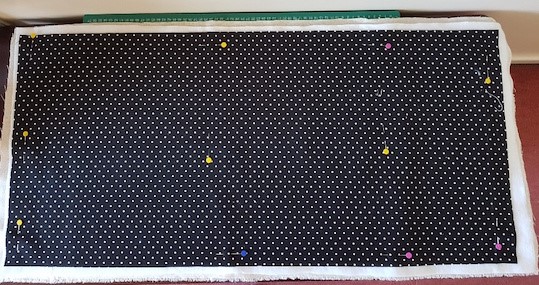 |
|||||||
|
Cut out the back panel fabric, which consists of: 1 x Front panel, 1 x Backing material, 1 x Wadding. The finished dimensions are shown in the cutting list on page 3. Important: When making up the back panel I cut the front material to size, but I cut the wadding and back material slightly larger. This gives me material to trim, after quilting and adding the pockets, but makes it neater. Place the backing material face down, then place the wadding on top with the front material face up to complete the sandwich. Press and fix in place with pins and/or 505 spray (or equivalent). Size of back panel: 3½” + 8” + 3” + 8” + 3” + 8” + 1½” = Total 35” high
|
|||||||
|
|
|||||||
|
Position and pin the top pocket panel in place, 3½” from the backing panel top. Sew along the bottom, just above the binding. The edges are not sewn at this stage as the pocket edges will be closed as part of the binding process, in a later step.
|
|||||||
|
|
|||||||
|
To complete the pockets, sew down the middle, 1/8” either side of the pocket joining seam. This creates the two pockets. |
|||||||
|
|
|||||||
|
Repeat the process for the other two pocket panels, using a 3” spacing between the panels. Trim the finished panel ready for binding. |
STEP 6 – Dowling Casing
|
|
|
Cut a strip 16 ½” x 4 |
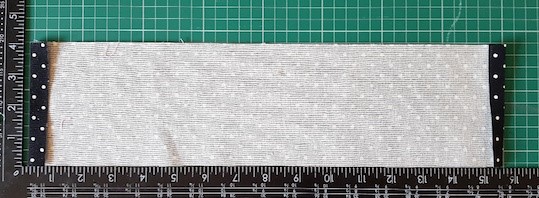 |
|
Fold, press and stitch ½” either side of the short sides |
|
|
|
Fold in half lengthways and sew short ends together.
Now pin to the reverse of the wall hanger placing the strip (with raw edges) at the top edge. Tack along the top, leaving the lower edge (folded) free for the moment. |
STEP 7 – Binding
|
|
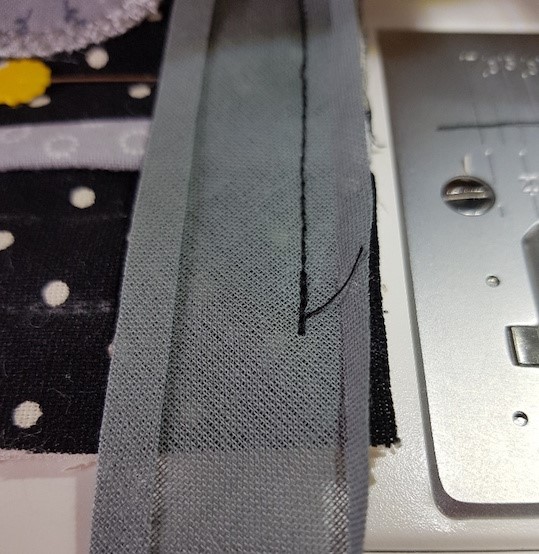 |
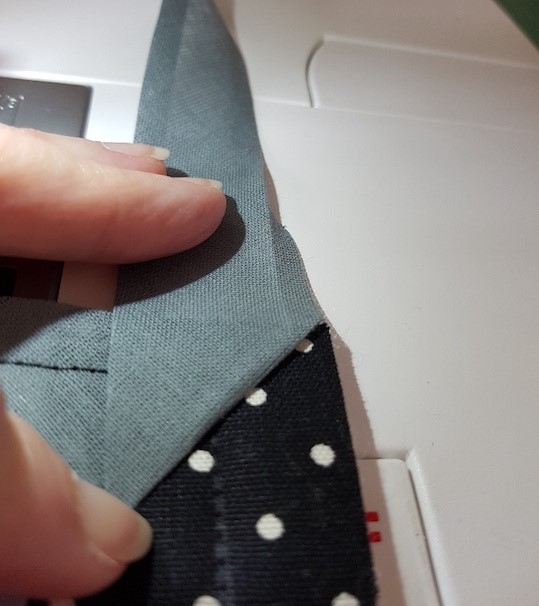 |
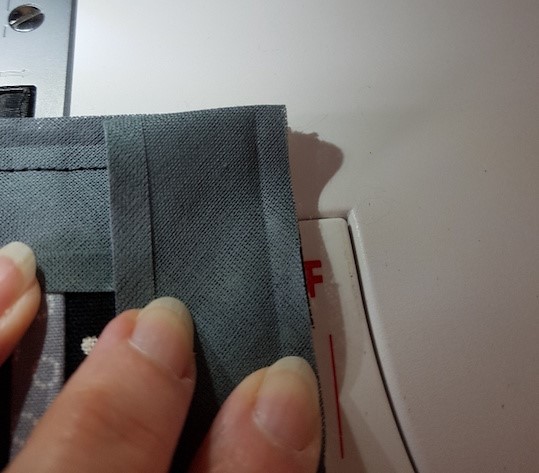 |
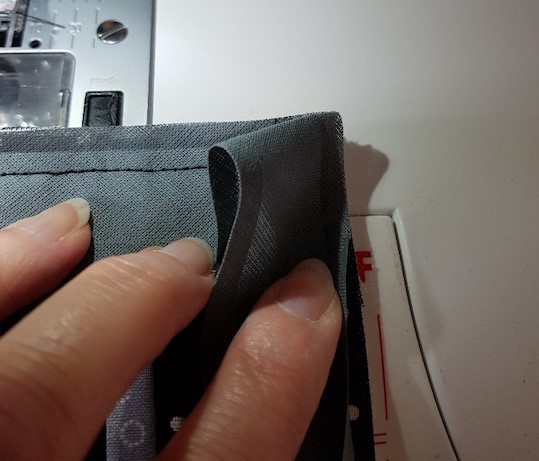 |
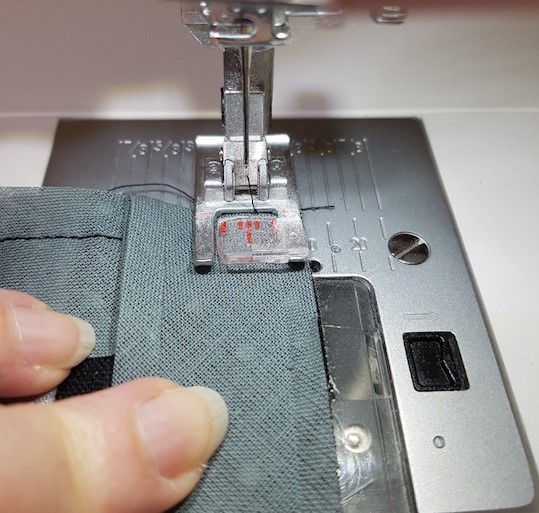 |
|
Now bind all around the hanger, remembering to mitre the corners, as shown above and remember NOT to attach the sides of the dowel casing. When binding is complete, sew about 1/8” along the bottom of the dowel casing, attaching it to the wall hanger and thus making the channel for the dowel / rod to hang it from.
You now have a finished, Style 1) Slip Pocket wall hanger. |
|
STEP A – Pleated Style 2) variant
|
|
|
IMPORTANT As Type 2) Pleated is more complicated it advisable to have made Type 1) Slip first, or, at least read all of the Type 1) instructions, as Type 2) instructions only covers how to create the pleated pockets. All other steps are as shown in Type 1) Slip. This method uses a bit more maths. I first created a paper template, on the basis of measuring twice, before cutting material from my stash. The actual finished pocket will be 6” x 6”. To the width of 6” I added 2½” to each side for folding and pleating to give a total width of 11”. I also needed to add a 1/4” neatening allowance top and bottom to the the square to give a total height of 6 ½”. So this is how we arrive at the overall size of 11” x 6 ½”. The general rule is therefore; no matter what size of finished pocket you require, add 5” to the width and ½” to the height. Cut 6 rectangles of fabric, each of 6 ½” x 11”. As per the other style, we are creating a finished wall hanger with 3 rows of 2 pockets. |
|
|
|
Create your pocket panels. In this case I used 4½” embroidery squares and added material to create a finished panel of 11” x 6 ½”, using ¼” seams to join the embroidery panel. |
|
|
|
Pocket panel shown from the back after pressing. |
|
|
|
Repeat the process to create 3 pocket panels. Then add the pockets linings and edging to top and bottom of pocket panels, as shown in Step 4) of Type 1).
|
Step B – Backing panel - Pleated
|
Size of back panel: 3½” + 6” + 3” + 6” + 3” + 6” + 1½” = Total 29” high
The width of my fully pleated pocket panel was 12¾”. So, my back panel width was trimmed to match this. |
STEP C – Making the Pleats
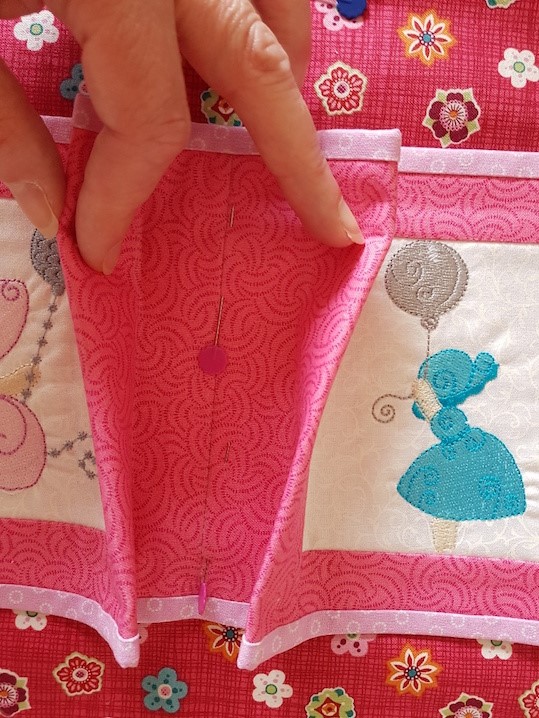 |
|
At the join of the 2 blocks mark 1” and 2” away from the seam to produce the first pleat. We need to do a mountain fold at the 2” line, then a valley fold on the 1” line. Fold and press, then clip or pin in place. Repeat for the other side of the seam. |
|
|
|
To pleat the ends of the panel, mark 1½” from the side edge then 2½”. Fold as previous mountain fold along the 2½” line and valley fold along the 1½”. This will leave ½” either side for attaching to the back panel. |
|
|
|
When attaching to the backing it is best to remove clips or pins which are holding the folds, at this stage, as it makes the next stage easier. Machine down the middle seam of the panels 3/8” either side of the joining seam. |
|
|
|
Machine down the edge of pocket panels, 1” from the edge. Important: the bottoms of the pocket panels are not machined until edge binding is completed. Repeat this for all 3 pocket panels. |
STEP D – Pleated Style – Finishing off
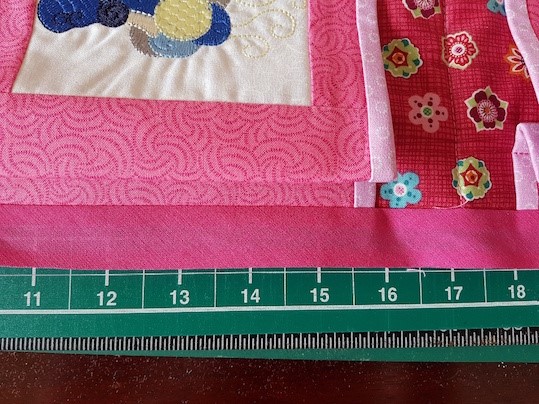 |
|
Once all 3 pocket panels are attached : - Create the dowel casing, as per the instructions for Style 1) Slip Pockets step 6. - Add the edge bias binding to back, as per the instructions for Style 1) Slip Pockets step 7. Picture above shows the bias binding attached and pressed away, ready to fold to the back. |
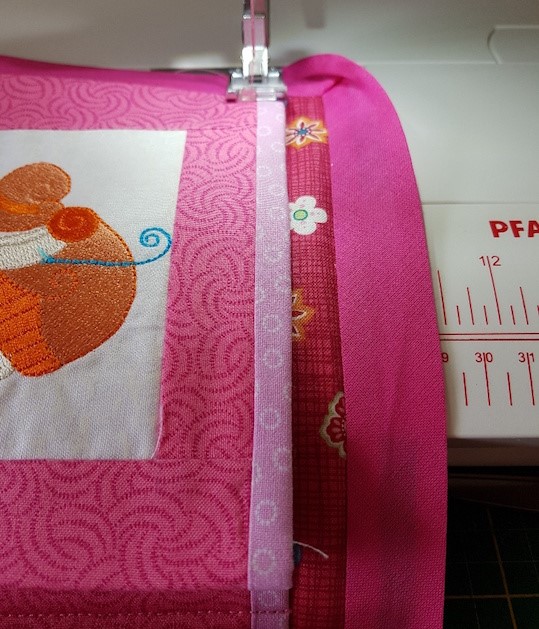 |
|
We are now going to sew along the bottom of each pocket panel, remembering to replace the folds. |
|
Make sure when sewing the bottom, the folds in the centre, are matched and it is advisable to reverse stitch for added security. Repeat for remaining 2 panels. Then complete as per Type 1), by pinning and then slip stitching the outer bias binding in place. You now have a fully completed Pleated Pocket wall hanger. |
Variants
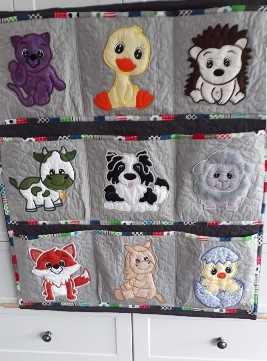 |
|
The original 9 pocket wall hanger that Jo Bendall made and posted on Kreative Kiwi Designs used from Large Applique Animals |
|
|
|
Another 9 pocket variant I made using the “Sewing Fairy” set from Kreative Kiwi. |
CONTACT DETAILS
Etsy Shop: PickleCreationsShop

